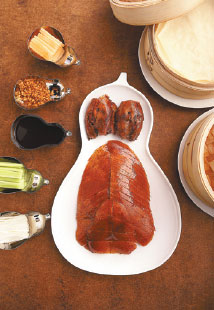 thing happens when you order the Peking duck at Jing Yaa Tang: When the armada of plates arrives at the table, it's not the succulent meat that draws your eye first - it's the pancakes. They look almost fluffy, curling slightly at the edges. You know right away that you won't be struggling to pull them apart while that delicious meat gets cold.
thing happens when you order the Peking duck at Jing Yaa Tang: When the armada of plates arrives at the table, it's not the succulent meat that draws your eye first - it's the pancakes. They look almost fluffy, curling slightly at the edges. You know right away that you won't be struggling to pull them apart while that delicious meat gets cold. "We make them in-house," says Li Dong, the chef de cuisine. "They are rolled out two at a time and cooked in batches of 10." They have a short shelf life, he explains, which is why not everybody takes the trouble.
Li is just as fussy about the ducks themselves. "The quality has to start at the source, and we buy our birds from one of the top duck farms in China," he says. "They must be 40 to 45 days old, and between 2 and 2.5 kilograms - smaller birds are too lean. But you don't want ducks that are too old either - those are soup ducks!"
The chef's English is halting, but his hands are bilingual as he gesticulates about his birds.
"They are inflated with air before leaving the farm factory, to separate the duck skin," he says through a translator, describing the beginning of a process to make sure the skin is really crisp and loose. The ducks get a hot bath on arrival at the restaurant, and then they are sugar-coated, to enhance both flavor and the color after roasting.
Li says his sauce recipe is a secret, but he shares a key ingredient: Chinese dates. "We use date wood to roast the ducks," he says, "so adding dates to the sauce complements the wood flavor." There's also a little mint to add to its freshness and to balance the duck's natural greasiness.
We're having this chat in the restaurant's glittering bar, a few days after I'd dropped in with a friend for dinner. I'd been eager to sample the menu since Jing Yaa Tang opened last year in the boutique hotel Opposite House. The spirit, decor and a handful of signature dishes were created by Alan Yau, the consulting cuisine guru for parent company Swire Hotels. Beyond that, the menu has been in the hands of Li, who heads a bright young kitchen team that's eager to show their mettle each time they toque up.
There are 60 or so dishes on the menu, which Li changes every four to six months. Every dish is artfully presented. I was pleased to find out that I'd chosen some of his own favorites at dinner the week before, including a sassy Sichuan poached chicken with crushed peanuts and sesame in spicy sauce, and the sublimely aromatic three-cup clay-pot codfish with basil.
While the place may have the aura of a Western restaurant, "at the end of the day we are serving Chinese food", says Li, whose family has been in the business since the 1940s. "We offer local specialties from across China, from the spicy fare of Sichuan to the savory dishes of Canton. We do try to avoid extreme flavors, so that every guest will be able to enjoy a comprehensive Chinese experience."
On a return visit, the group at my table started with chilled cherry tomatoes marinated in plum sauce, then plumped for two of Li's best sellers: Pork neck clay pot with ginger and garlic is a typical Cantonese dish, a nice foil for the spicy Sichuan beef and tofu stew. We also couldn't resist the house fried rice, an exalted creation with succulent scallops and XO sauce.
And, of course, a beautifully roasted duck.





